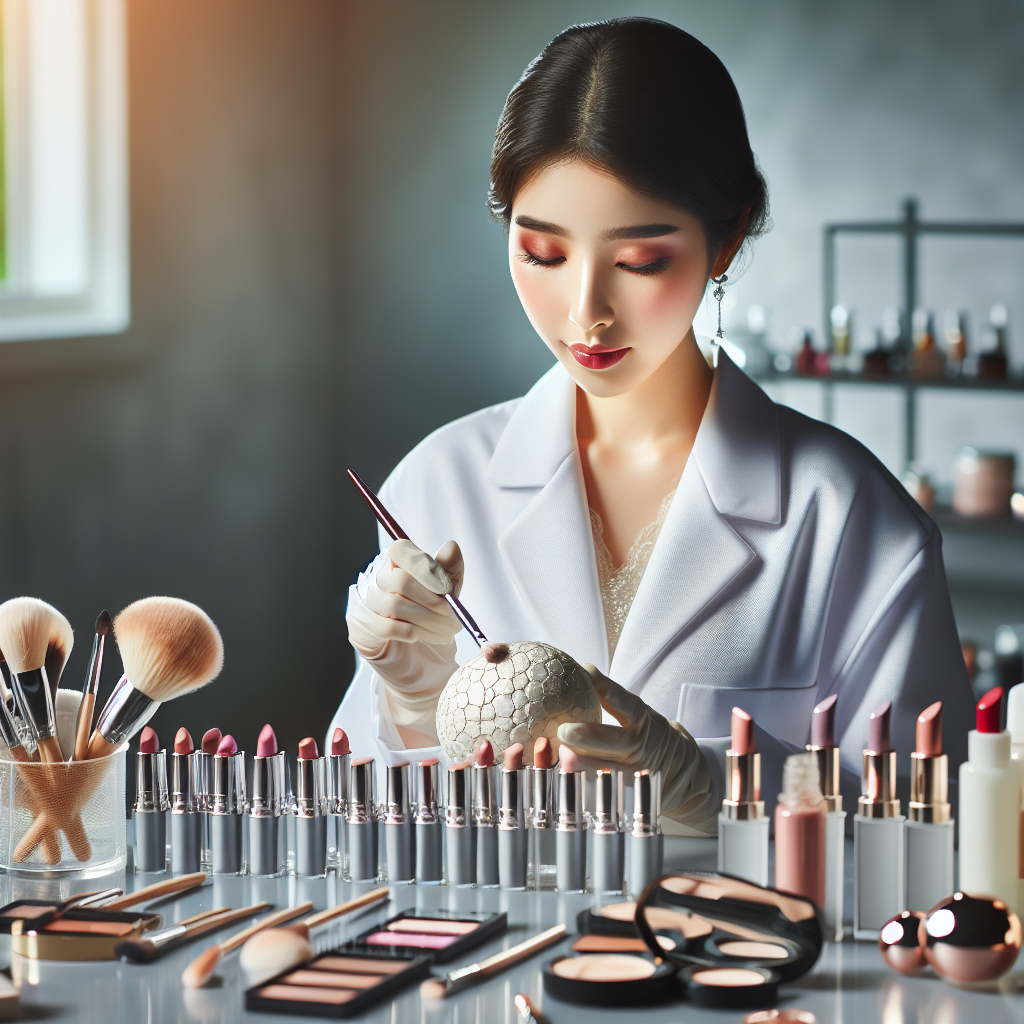In today's beauty-conscious world, the demand for cruelty-free makeup is more significant than ever. Consumers are becoming increasingly aware of the ethical implications of their purchases and are seeking products that align with their values. But what exactly does it mean for makeup to be cruelty-free, and how is it tested? This article delves into the world of cruelty-free makeup testing, shedding light on the methods used to ensure that these beauty products are free from animal testing.
Cruelty-free makeup is defined as products that are not tested on animals at any stage of their development. This means that from the initial ingredient testing to the final product, no animals are harmed in the process. The transition to cruelty-free practices has been facilitated by advancements in science, allowing for alternative testing methods that do not compromise on safety or efficacy.
As you embark on your journey to understand cruelty-free makeup testing, you'll discover the various techniques and certifications that guarantee a product's ethical integrity. Embracing cruelty-free options not only supports animal welfare but also encourages a shift towards more sustainable and humane practices in the beauty industry. Visit our website to learn more and get started today! Click here.
Understanding Cruelty-Free Makeup

Understanding cruelty-free makeup starts with recognizing the ethical considerations and the certification processes that define such products. At its core, cruelty-free makeup refers to cosmetics that are developed without any form of animal testing. This is a crucial distinction for consumers who prioritize animal welfare and seek to make informed purchasing decisions.
The journey towards cruelty-free makeup often begins with a commitment from brands to eliminate animal testing from their research and development processes. This involves a thorough review of ingredient sourcing, ensuring that suppliers also adhere to cruelty-free practices. Brands must then undergo rigorous certification processes conducted by independent organizations, such as Leaping Bunny or PETA, which verify their claims and grant official cruelty-free status.
These certifications are not just labels; they represent a brand's dedication to ethical practices and transparency. By displaying a cruelty-free certification, companies signal to consumers that they have met stringent criteria and are committed to humane practices. This helps build trust and loyalty among a growing demographic of ethically-conscious consumers.
Moreover, cruelty-free makeup is often part of a broader commitment to sustainability and environmental responsibility. Many cruelty-free brands also focus on using natural, organic, and vegan ingredients, further aligning with a holistic approach to beauty that respects both animal life and the planet.
By understanding what cruelty-free makeup entails, consumers can make more informed choices and support brands that champion ethical values. This not only promotes animal welfare but also encourages the beauty industry to evolve towards more humane and sustainable practices.
Alternative Testing Methods for Cruelty-Free Makeup

In the quest to eliminate animal testing, the beauty industry has embraced a variety of alternative testing methods for cruelty-free makeup. These innovative techniques ensure product safety without compromising on ethical standards.
In vitro testing is one of the most widely used alternatives. This method involves testing on cell cultures or tissue samples in a controlled laboratory environment. In vitro testing can effectively predict how human skin will react to a product, providing reliable safety data without the need for animal subjects.
Computer modeling, also known as in silico testing, utilizes advanced software to simulate human biology and predict how substances will interact with the body. By using existing data and sophisticated algorithms, in silico testing can assess potential toxicity and efficacy, offering a cruelty-free and cost-effective alternative to traditional animal testing.
Human volunteer studies are another crucial method. These studies involve small groups of volunteers who test products under strict medical supervision. This real-world testing provides valuable insights into how products perform on actual human skin, ensuring both safety and effectiveness.
3D skin models have also gained traction as a revolutionary alternative. These models are created from human cells and mimic the structure and function of real human skin. They can be used to test for irritation, corrosion, and other reactions, providing a highly accurate representation of how a product will behave when applied to human skin.
By employing these alternative testing methods, the beauty industry can continue to innovate and ensure product safety without the ethical concerns associated with animal testing. Consumers can feel confident that the cruelty-free makeup they choose is both safe and ethically produced, aligning with their values of compassion and sustainability.
Certifications for Cruelty-Free Makeup

When it comes to identifying cruelty-free makeup, certifications play a critical role. These certifications are awarded by various organizations dedicated to promoting ethical practices in the beauty industry. They help consumers make informed choices by ensuring that the products they purchase are truly cruelty-free.
One of the most recognized certifications is the Leaping Bunny program. Managed by the Coalition for Consumer Information on Cosmetics (CCIC), the Leaping Bunny logo signifies that a product has met stringent criteria, including a commitment to not conducting animal testing at any stage of product development. Brands must undergo regular independent audits to maintain this certification.
The PETA Cruelty-Free certification is another prominent standard. PETA (People for the Ethical Treatment of Animals) maintains a comprehensive list of companies that have pledged to be cruelty-free. Products bearing the PETA Cruelty-Free logo assure consumers that no animal testing has been conducted, either by the company or its suppliers.
Choose Cruelty Free (CCF) is an Australian organization that provides certification to companies that adhere to their cruelty-free standards. The CCF logo is a trusted symbol for Australian consumers looking for ethical beauty products. This certification also extends to vegan products, ensuring that no animal-derived ingredients are used.
Another important certification is from Beauty Without Bunnies, a global program by PETA. This certification is available to companies worldwide and assures consumers that the products are free from animal testing. Companies must submit a detailed questionnaire and sign a statement of assurance to be listed under this certification.
These certifications not only guide consumers but also encourage brands to adopt cruelty-free practices. By choosing products with these trusted logos, consumers can confidently support ethical brands and contribute to a more humane beauty industry.
The Importance of Cruelty-Free Makeup

Choosing cruelty-free makeup is more than just a personal preference; it is a significant step towards fostering ethical and humane practices within the beauty industry. The importance of cruelty-free makeup cannot be overstated, as it directly impacts animals, the environment, and consumer health.
First and foremost, cruelty-free makeup ensures that no animals are harmed during the testing process. Traditional animal testing methods often involve painful and distressing procedures on animals like rabbits, mice, and guinea pigs. By opting for cruelty-free products, consumers can take a stand against these inhumane practices and support alternative testing methods that do not involve animals.
Moreover, cruelty-free brands often prioritize environmental sustainability. Many cruelty-free companies also adhere to eco-friendly practices, such as using sustainable packaging and sourcing natural, non-toxic ingredients. This holistic approach not only reduces the environmental footprint of beauty products but also promotes overall well-being for the planet.
From a consumer health perspective, cruelty-free makeup is often free from harmful chemicals and additives. Ethical brands tend to focus on using natural and organic ingredients, which are gentler on the skin and less likely to cause allergic reactions or other health issues. This commitment to quality and safety makes cruelty-free products a healthier choice for consumers.
Additionally, supporting cruelty-free brands sends a powerful message to the beauty industry. It signals to companies that consumers value ethical practices and are willing to invest in products that align with their values. This consumer demand can drive significant changes within the industry, encouraging more brands to adopt cruelty-free and ethical practices.
In summary, the importance of cruelty-free makeup extends beyond individual choices. It encompasses animal welfare, environmental sustainability, and consumer health, making it a vital consideration for conscientious beauty enthusiasts everywhere.
How to Support Cruelty-Free Beauty Brands
Supporting cruelty-free beauty brands is a crucial step towards ensuring ethical and humane practices in the beauty industry. Here are some practical ways you can contribute to the cause and make a positive impact:
1. Do Your Research: Before purchasing a product, take the time to research whether the brand is genuinely cruelty-free. Look for certifications from reputable organizations such as Leaping Bunny, PETA’s Beauty Without Bunnies, or Cruelty Free International. These certifications ensure that the products have not been tested on animals at any stage of development.
2. Read Labels Carefully: Check the product packaging for cruelty-free logos and statements. Be cautious of vague or misleading claims, and always verify them through trusted resources.
3. Support Ethical Brands: Choose to buy from companies that are transparent about their cruelty-free policies. Many brands go the extra mile by also committing to vegan formulations, sustainable practices, and ethical sourcing of ingredients.
4. Spread Awareness: Educate your friends and family about the importance of cruelty-free makeup. Share information on social media, write reviews, and promote brands that prioritize humane practices.
5. Make the Switch Gradually: Transitioning to a completely cruelty-free beauty routine can be overwhelming. Start by replacing your most commonly used products with cruelty-free alternatives, and gradually phase out non-cruelty-free items from your collection.
6. Use Cruelty-Free Apps: There are several mobile apps available that can help you identify cruelty-free brands and products. Apps like Bunny Free, Cruelty Cutter, and Leaping Bunny make it easy to find and support ethical options while shopping.
By taking these steps, you can make a significant difference in the fight against animal testing and promote a more humane and ethical beauty industry.
Visit our website to learn more and get started today! Click here.
